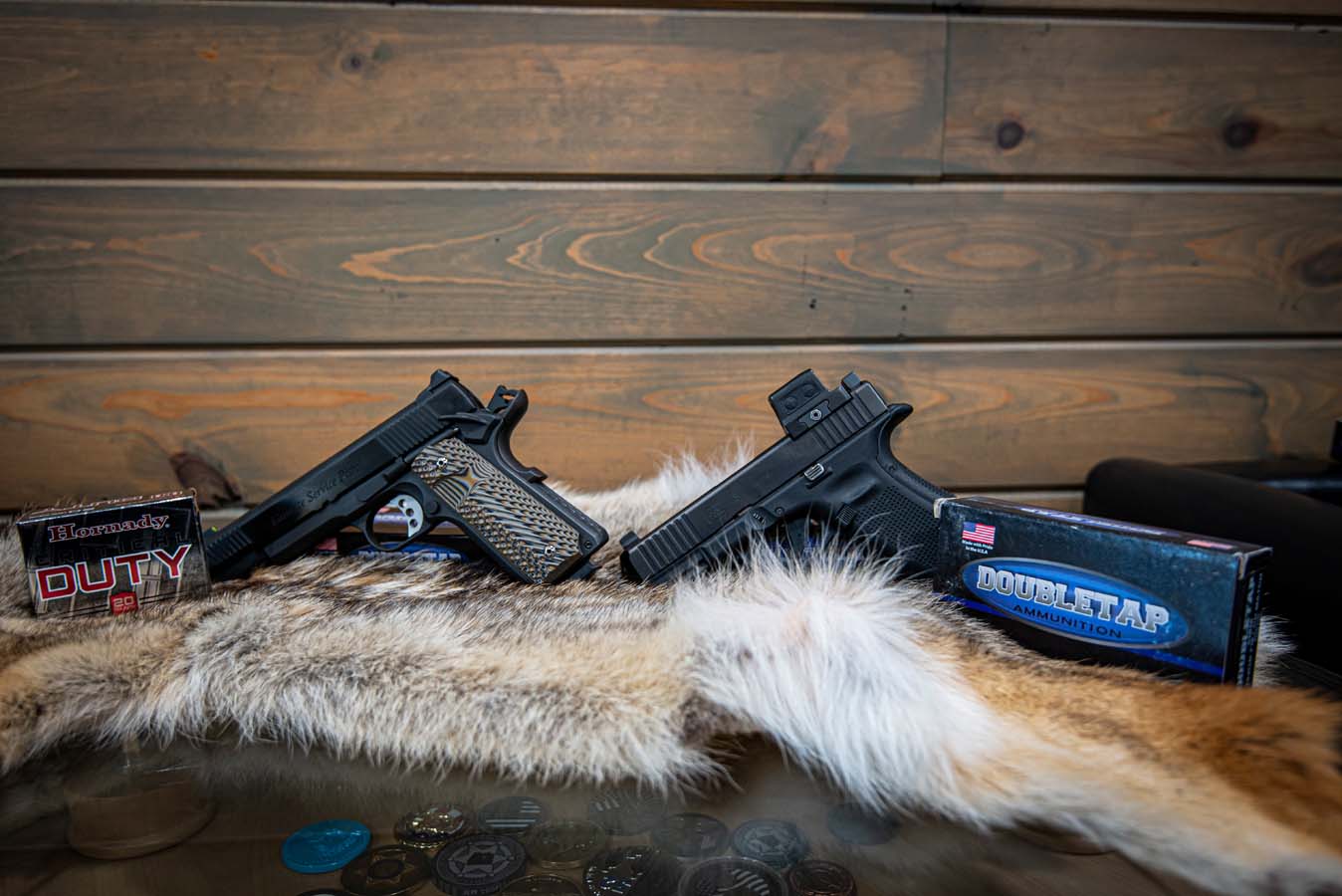When Gunsite announced the availability of a new Gunsite Glock Service Pistol (GGSP) at the famed Academy’s Pro Shop, there were some unconfirmed rumors that Jeff Cooper turned over in his grave. I suspect these rumors were started by folks who had not paid proper attention to the Colonel’s teachings over the years.
Colonel Cooper was a man who based his opinions on observations of actual events, not speculations about what might happen in the future. During the Leather Slap Contests at Big Bear during the 1960s (the predecessor of today’s action shooting games and the inspiration for Cooper founding the original American Pistol Institute in 1976), the John Browning-designed 1911 pistol dominated the winners’ circle. Paying careful attention to the techniques used in achieving success with the handguns available, Cooper developed a teaching format for the modern service pistol.
As Gunsite Academy (the renamed American Pistol Institute) enters its 48th successful year of teaching Americans how to defend themselves with firearms, those teaching techniques — along with updates incorporating the new breed of defensive pistols, rifles, and shotguns — are still being taught at both the original site in Paulden, Arizona, and selected installations around the country. One of the big items on my bucket list is to attend Gunsite’s 50th Anniversary festivities.
What Colonel Cooper didn’t see on the firing line (because it didn’t exist in 1976) was the Glock handgun and the incredible success it would have by the year 2000 and into the new millennium. The Austrian “Tupperware Pistol,” as its detractors originally called it, has been sold by the millions and is used by more police and military institutions than any other handgun on the market.
During that same period, ammunition companies have invested millions of dollars to improve the terminal ballistic effects of 9mm ammunition. Combine the Glock’s incredible simplicity and reliability with a magazine capacity more than double that of the 1911, and you have a defensive pistol that can’t be ignored.
When the Glock became the most prevalent pistol brought to Gunsite by students, it was definitely time to make a statement. While different handguns have been sold in the Academy Pro Shop since its opening, the Gunsite Service Pistol or GSP had always been a Browning-designed 1911 chambered for the .45 ACP. Enter the Gunsite Glock Service Pistol.
One good thing about Glocks is that anyone who knows anything about handguns knows precisely what the gun looks like simply by saying “Glock.”
And while Gunsite added some things to the GSSP, the new gun is still instantly recognized as a Glock. If you’re a serious aficionado of the Austrian pistol and the GGSP strikes you as being slightly wrong dimensionally, it’s because it utilizes the shorter slide of a Model 19 on the frame of the higher-capacity Model 17. Shorter length, higher ammo capacity: sounds like a win/win combination.
The most noticeable feature of the GSSP is the inclusion of a Holosun HE509T red-dot optic mounted on top of the slide just in front of the rear sight. This was not an afterthought on the part of the Gunsite Training staff. About half the students attending these days are showing up with optics mounted on their pistols.
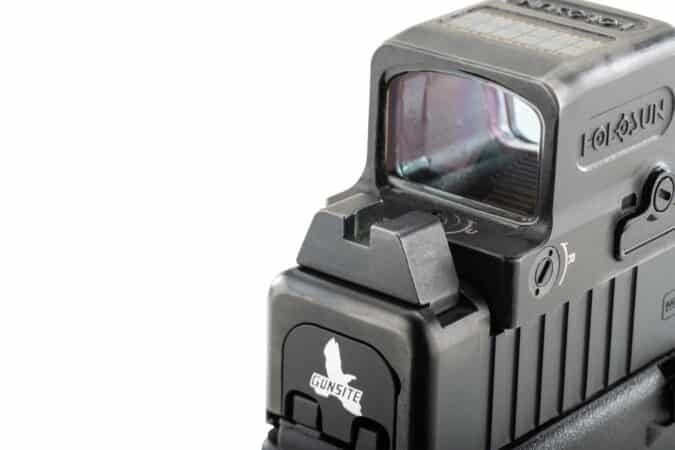
More importantly, new shooters are performing better with guns so equipped compared to students with iron sights. In addition, police department trainers are reporting improved scores from the recruits coming through the various police academies. These are the real-world results that Colonel Cooper reviewed when he first codified the training doctrine for the modern service pistol.
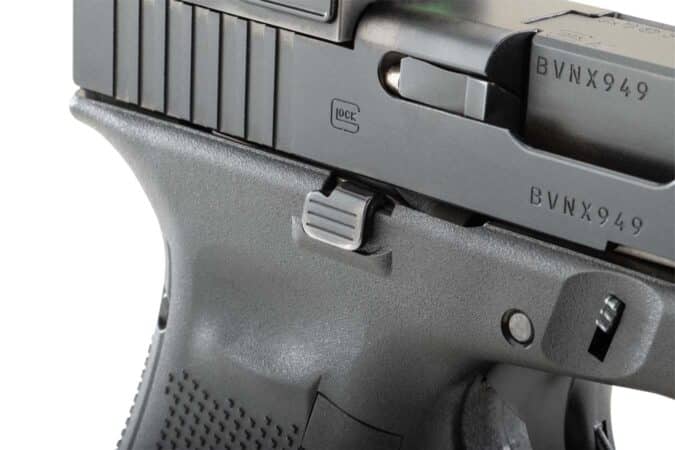
Upgrading one’s training program to incorporate new developments in equipment and techniques is essential to maintaining proper skills, both for civilians and law enforcement/military personnel. So what if the enhanced performance is primarily the result of a generation of Americans that grew up playing video games using optics on their weapons? The improved skills demand recognition.
The Holosun 509T has a solid titanium frame for enhanced survivability and utilizes solar and battery power to run the optic. Unlike other optics, the Holosun does not use adapter plates for mounting on the slide; it fits precisely into a slot machined into the top of the slide.
The Holosun’s mounting screws hold the optic to the slide; they do not see any shear loads because the Holosun frame is braced on both ends by the slide itself. Looking through the generous window of the 509T, you can have two presentations.
One is a 32-MOA circle surrounding a conventional single 2-MOA dot. With a touch or two of the finger, you can change the presentation by eliminating the outer circle and leaving the more conventional center dot; it’s your choice. When carried in your holster, the optic remains dormant. Drawing the pistol turns on the power, and it’s “Bandits beware!” The tall iron sights designed to allow aimed fire over an installed suppressor are co-witnessed through the Holosun window, so the old-fashioned iron sights will always be available if needed to finish a fight.
The Gunsite Glock features a few other non-standard modifications that range from productive (i.e., improve your fighting skills) to cosmetic (i.e., gotta have that!). The fire control system has a “Minus Connector.” While using negative adjectives like “Minus” in describing a new gun feature is generally frowned upon in marketing circles, it’s accurate. The connector reduces the trigger pull weight of the new Glock by something over a pound.
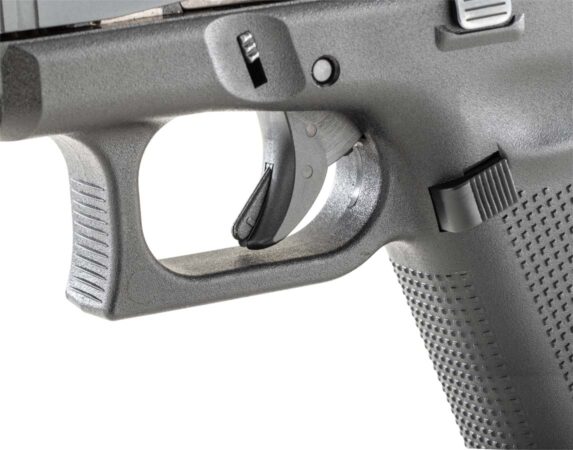
It’s still rather long and spongy, but you can feel the reduction in overall weight. I didn’t do long-range precision shooting drills with the gun while at the Academy, but I think the newer, lighter trigger will be an advantage as engagement ranges increase. The slightly enlarged and rounded FBI magazine release button was helpful in reloading drills.
I can’t offer any serious comment on the lanyard loop installed on the bottom rear of the grip frame.
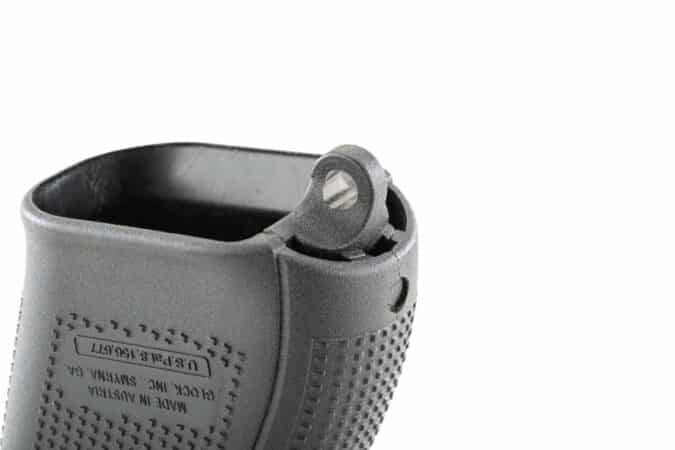
I know its purpose is to keep the gun in your possession in case you lose your grip, but I’ve never seen one used except in old movies featuring British troops posted in various countries around the world in the 19th and early 20th centuries. I guess the fact that I saw them used in old-time movies confirms Gunsite’s “historic” rationale. And while the current and retro Gunsite logos and the word “GUNSITE” on the top of the slide and backplate may not improve your shooting skills, they always do wonders for my mood.
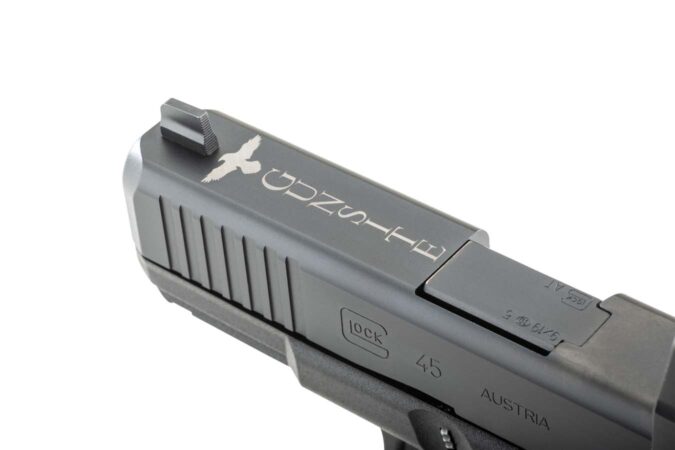
Given the amount of Gunsite logo gear sold in the Academy Pro Shop, both the word and the bird belong on these guns.
Manufacturing arrangements differ for the .45 ACP GSP than the 9mm GGSP. Whereas the Gunsite Glock Service Pistols are built by Glock and delivered complete to the Gunsite Pro Shop, the 1911s are assembled on-site at the Gunsite Gunsmithy using purchased precision-built components.
Seeing the first three items on the list of components for this newest standard-sized 1911 warmed my heart: forged steel frame, forged steel slide, and hammer-forged match barrel. The Academy’s on-site gunsmithy is Finks Custom Gunsmithing, and based on custom work I’ve had by the shop in the past, the new GSP couldn’t be anything but a superb defensive pistol.
Sitting in the furnished transport case, the GSP was obviously (at least to this old 1911 shooter) a purpose-built handgun meant to save your life. An initial inspection of the weapon revealed many of the custom features I like. The extended beavertail grip safety with the oversized bulge at the base is essential for two reasons.
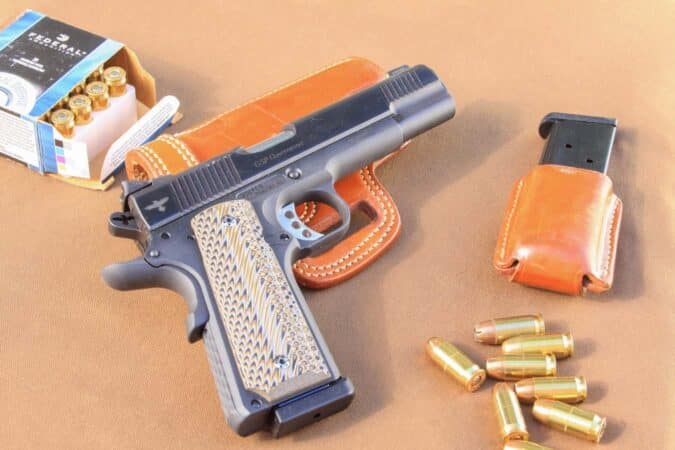
First, any prolonged training session can result in multiple slide cuts to the web of your shooting hand without the wide flare at the top of the safety. Second, without the oversized bulge at the base of the safety, I have trouble fully disengaging the grip safety with a shooting grip that keeps my shooting hand thumb on top of the thumb safety. In an article in the late 1980s, Cooper pointed out that this phenomenon occurs with a relatively high percentage of shooters.
The iron sight setup is excellent, consisting of a Wilson Combat Battlesight with a blacked-out U-notch and a Novak front tritium yellow outline night sight. While shooting at Gunsite, Rangemaster Lew Gosnell ran us through some drills consisting of single, timed headshots, each requiring an individual presentation from the holster.
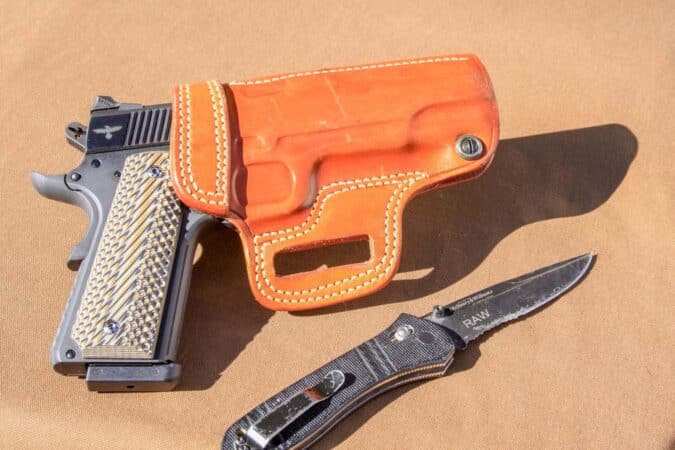
Engagement ranges began at 3 yards and backed up to 25 yards, with different times allowed at each distance. After six shots, I had five inside the snot box on the Gunsite silhouette targets and one just an inch above the dividing line. It was the best performance I’ve ever achieved on that exercise with any sight system — optics or irons.
I like the feel of G10 grips; they offer a rough surface without sharp edges, and a dished-out area behind the magazine release button that facilitates both speed and tactical reloads. Likewise, the scalloped mainspring housing provided anti-slip protection and quicker shot-to-shot recovery without overly aggressive surfaces. Finally, the frontstrap’s slightly rougher satin-finished surface and rather gentle vertical serrations help maintain control during recoil — a nicely done system to facilitate a faster rate of fire. Wilson Combat’s single-side tactical thumb safety worked perfectly on every presentation and could easily be operated by my support hand. I can’t make a case for an ambidextrous thumb safety on the GSP.
Other obvious and useful features on the GSP that most respected gunsmiths recommend include the lowered and flared ejection port, the triggerguard undercut to keep your shooting hand as close as possible to the bore axis, and throat and reliability work on a match barrel with a recessed target crown for those of us who are too clumsy to complete all our ballet lessons. Front and rear slide serrations make manual slide operations and chamber checks much easier, and a beveled magwell greatly facilitates reloads.
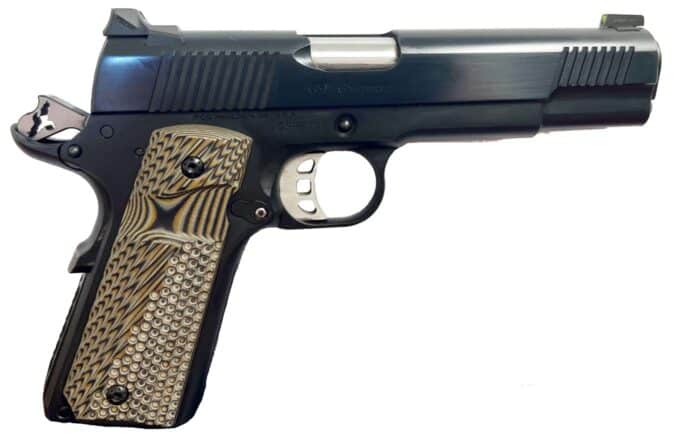
To paraphrase Dorothy in The Wizard of Oz, “There’s no trigger like a 1911 trigger!” Dave Fink sets the GSP’s skeletonized match trigger at 4.25 pounds with no creep. When you carry a fighting handgun with a trigger pull like this, precise shot placement becomes the predictable norm.
Fink’s Custom dehorn package is a nice touch, something we’re seeing less of in recent years as some custom gunsmiths seem to think that sharp edges are proof of precision machining. When you’re getting close to the end of your first hundred rounds fired in a serious Gunsite handgun training class, you’ll appreciate your dehorn package and the fact that you’re the only student in the class who hasn’t been whining at the instructor for some more Band-Aids and adhesive tape.
The cosmetic engraving on the 1911 GSP is slightly downsized and subdued compared to the Glock but just as pleasing. The left side of the slide has the words Government Service Pistol in large print. On the right side of the slide under the ejection port is the Finks gunsmithing logo and the letters F.C.G. Paulden, AZ, while the current Gunsite raven logo rests proudly just behind the rear slide serrations. But, to me, the crown jewel is the Gunsite raven cut into the 1911’s hammer. I mean, if you’re going to skeletonize the hammer by making a hole in it, why should that hole be anything but the instantly recognizable (and dare I say it) “World-famous duck of death?”
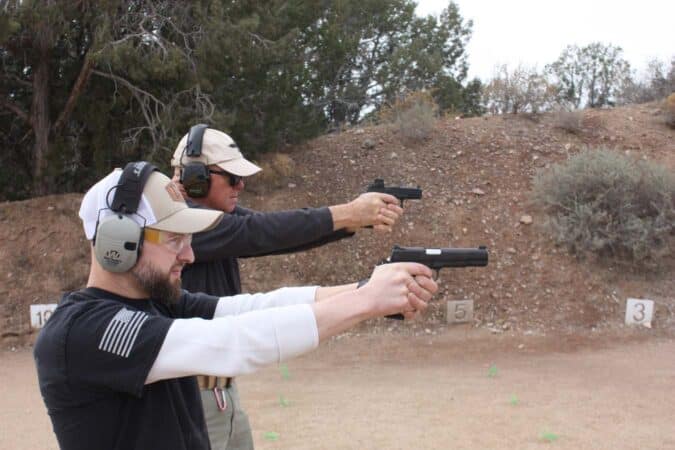
Since these are serious fighting handguns, I want to finish on defensive capabilities rather than discussing cosmetics. A group of gun writers spent three days at Gunsite with optics-equipped Glocks, going through several drills and training techniques offered in the school’s classes.
At my age, the winter temperatures kept me huddled over the heater in my truck until the afternoon sessions when the thermometer finally broke 40 degrees. In addition to being a California sissy, I didn’t have the benefit of growing up on video games. Although I have used dot optics successfully on two of my hunting handguns, I’d never used one in a scenario where I was the prey and time was of the essence.
The 32-MOA outer circle seemed a little too busy for me, so I set the selector switch to the 2-MOA center red dot only. By the third day, I was still searching for the dot every time I pulled the Glock from the holster. Simple solution: I needed more coaching, practice, and warmer weather. A five-day Gunsite 250 class in March or April using a GGSP would sort things out. Meanwhile, knowing from handgun hunting experience the increased accuracy results you can get at ranges well beyond 25 yards, I have installed a Holosun 509T on an extra slide for my Glock 19 and will be looking for more range time.
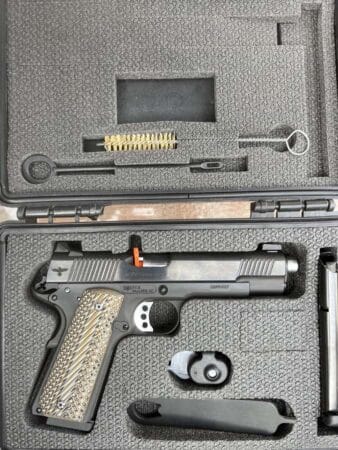
From my handgun hunts over the past few years, it’s clear that I can make more precise shots with a handgun using red-dot optics than iron sights. However, hunting is a much different scenario than the defensive use of handguns. When hunting, you are the predator, not the prey, which allows you to choose when to take the first shot instead of reacting quickly to a threat against you or your loved ones.
I don’t yet know whether or not I will switch to a red dot-equipped CCW gun full-time. I’m no Rob Leatham with a 1911, but I have acquired some reasonable skills at close range in fast-action/reaction engagements. Using an open-sight 1911 like the GSP with its superb trigger, I can make hits at longer ranges.
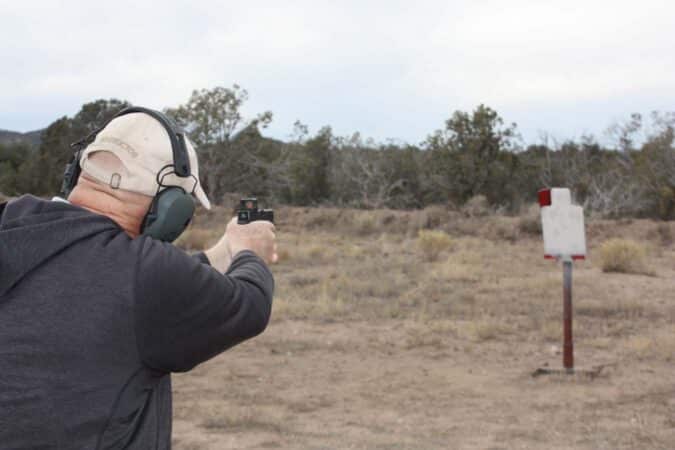
My initial thoughts make me lean toward the ease of concealing an iron-sighted pistol, but today’s holsters offer some excellent carry options that are relatively easy to hide. I suspect my decision may vary daily based on several other non-performance considerations. Regarding the choice between 9mm and .45 ACP? No, you’re not sucking me into that black hole of lost discussions!
Read the full article here

